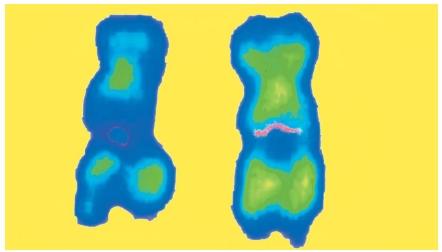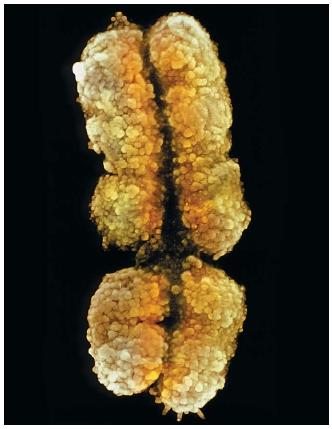Chromosome
A chromosome is a structure that occurs within cells and that contains the cell's genetic material. That genetic material, which determines how an organism develops, is a molecule of deoxyribonucleic acid (DNA). A molecule of DNA is a very long, coiled structure that contains many identifiable subunits known as genes.
In prokaryotes, or cells without a nucleus, the chromosome is merely a circle of DNA. In eukaryotes, or cells with a distinct nucleus, chromosomes are much more complex in structure.
Historical background
The terms chromosome and gene were used long before biologists really understood what these structures were. When the Austrian monk and biologist Gregor Mendel (1822–1884) developed the basic ideas of heredity, he assumed that genetic traits were somehow transmitted from parents to offspring in some kind of tiny "package." That package was later given the name "gene." When the term was first suggested, no one had any idea as to what a gene might look like. The term was used simply to convey the idea that traits are transmitted from one generation to the next in certain discrete units.

The term "chromosome" was first suggested in 1888 by the German anatomist Heinrich Wilhelm Gottfried von Waldeyer-Hartz (1836–1921). Waldeyer-Hartz used the term to describe certain structures that form during the process of cell division (reproduction).
One of the greatest breakthroughs in the history of biology occurred in 1953 when American biologist James Watson (1928– ) and English chemist Francis Crick (1916– ) discovered the chemical structure of a class of compounds known as deoxyribonucleic acids (DNA). The Watson and Crick discovery made it possible to express biological concepts (such as the gene) and structures (such as the chromosome) in concrete chemical terms.
The structure of chromosomes and genes
Today we know that a chromosome contains a single molecule of DNA along with several kinds of proteins. A molecule of DNA, in turn, consists of thousands and thousands of subunits, known as nucleotides, joined to each other in very long chains. A single molecule of DNA within a chromosome may be as long as 8.5 centimeters (3.3 inches). To fit within a chromosome, the DNA molecule has to be twisted and folded into a very complex shape.
Words to Know
Deoxyribonucleic acid (DNA): The genetic material in the nucleus of cells that contains information for an organism's development.
Eukaryote: A cell with a distinct nucleus.
Nucleotide: The building blocks of nucleic acids.
Prokaryote: A cell without a nucleus.
Protein: Large molecules that are essential to the structure and functioning of all living cells.
Imagine that a DNA molecule is represented by a formula such as this:
-[-N 1 -N 4 -N 2 -N 2 -N 2 -N 1 -N 3 -N 2 -N 3 -N 4 -N 1 -N 2 -N 3 -N 3 -N 1 -N 1 -N 2 -N 3 -N 4 -]
In this formula, the abbreviations N 1 , N 2 , N 3 , and N 4 stand for the four different nucleotides used in making DNA. The brackets at the beginning and end of the formula mean that the actual formula goes on and on. A typical molecule of DNA contains up to three billion nucleotides. The unit shown above, therefore, is no more than a small portion of the whole DNA molecule.
Each molecule of DNA can be subdivided into smaller segments consisting of a few thousand or a few tens of thousands of nucleotides. Each of these subunits is a gene. Another way to represent a DNA molecule, then, is as follows:
-[-G-D-N-E-Y-D-A-B-W-Q-X-C-R-K-S-]-
where each different letter stands for a different gene.
The function of genes and chromosomes
Each gene in a DNA molecule carries the instructions for making a single kind of protein. Proteins are very important molecules that perform many vital functions in living organisms. For example, they serve as hormones, carrying messages from one part of the body to another part; they act as enzymes, making possible chemical reactions that keep the cell alive; and they function as structural materials from which cells can be made.
Every cell has certain specific functions to perform. The purpose of a bone cell, for example, is to make more bone. The purpose of a pancreas cell, on the other hand, might be to make the compound insulin, which aids in the manufacture of glucose (blood sugar).
The job of genes in a DNA molecule, therefore, is to tell cells how to manufacture all the different chemical compounds (proteins) they need to make in order to function properly. The way in which they carry out this function is fairly straightforward. At one point in the cell's life, its chromosomes become untangled and open up to expose their genes. The genes act as a pattern from which proteins can be built. The proteins that are constructed in the cell are determined, as pointed out above, by the instructions built into the gene.
When the proteins are constructed, they are released into the cell itself or into the environment outside the cell. They are then able to carry out the functions for which they were made.
Chromosome numbers and Xs and Ys
Each species has a different number of chromosomes in their nuclei. The mosquito, for instance, has 6 chromosomes. Lilies have 24, earthworms 36, chimps 48, and horses 64. The largest number of chromosomes are found in the Adder's tongue fern, which has more than 1,000 chromosomes. Most species have, on average, 10 to 50 chromosomes. With 46 chromosomes, humans fall well within this average.
The 46 human chromosomes are arranged in 23 pairs. One pair of the 23 constitute the sex hormones, called the X and Y chromosomes. Males have both an X and a Y chromosome, while females have two X chromosomes. If a father passes on a Y chromosome, then his child will be male. If he passes on an X chromosome, then the child will be female.

The X chromosome is three times the size of the Y chromosome and carries 100 times the genetic information.
However, in 2000, scientists announced that the X and Y chromosomes were once a pair of identical twins. These identical chromosomes were found some 300 million years ago in reptiles, long before mammals arose. The genes in these creatures did not decide sex on their own. They responded to some environmental cue like temperature. That still goes on today in the eggs of turtles and crocodiles. But in a single animal at that time long ago, a mutation occurred on one of the pair of identical chromosomes, creating what scientists recognize today as the Y chromosome—a gene that when present always produces a male.
[ See also Genetic disorders ; Genetic engineering ; Genetics ; Mendelian laws of inheritance ; Molecular biology ; Mutation ; Nucleic acid ; Protein ]
GOD BLESS.
define cancer ?
what is the chemistry of cancer ?
How is the genes able to carry out its' functions?
My homework says "What two functions do the X- and Y-chromosomes perform in humans?". I know that one of them is gender, but what exactly is the other one? I was kind of confused on this.